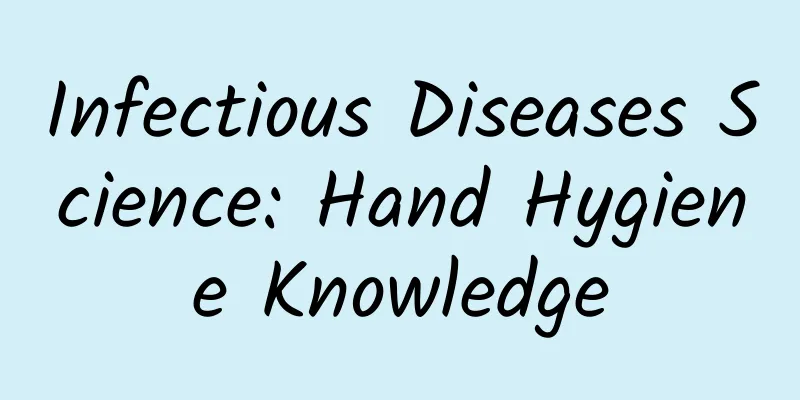Infectious Diseases Science: Hand Hygiene Knowledge

|
How important is hand hygiene? In 2009, the World Health Organization decided to designate May 5th of each year as "World Hand Hygiene Day" to emphasize the importance of improving hand hygiene of medical staff and reducing medical-associated infections during medical care. In 2008, the Public-Private Partnership for Handwashing with Soap (PPPHW) advocated the concept of "Global Handwashing Day", calling on countries around the world to carry out handwashing activities with soap on October 15th every year starting from 2008. "Global Handwashing Day" was born, which shows the importance of hand hygiene. Data show that 16 million patients die from hospital infections every year worldwide. The World Health Organization believes that strict hand hygiene measures can reduce hospital infections by 30%. Based on this, hand hygiene has become the most feasible and important measure to reduce hospital infections, especially hospital infections of drug-resistant strains, most of which are transmitted through the hands of medical staff. Therefore, as a medical worker, we must be deeply aware of the importance of hand hygiene. It is our unshirkable responsibility to follow hand hygiene in our daily work. Today, the author will take you to the hospital infection department to learn about the hand hygiene knowledge of the infection department! How do medical staff wash their hands? Needless to say, the hand hygiene of medical staff must be more stringent. my country's "Medical Staff Hand Hygiene Standards" points out that "rub your hands carefully for at least 15 seconds" and provides detailed steps in Appendix A, as follows: A.1 Wet your hands under running water. A.2 Take an appropriate amount of hand sanitizer (soap) and apply it evenly to the entire palm, back of the hand, fingers and between the fingers. A.3 Rub your hands carefully for at least 15 seconds, paying attention to cleaning all the skin on your hands, including the backs, fingertips and spaces between your fingers. The specific rubbing steps are as follows (in no particular order): A.3.1 Place your palms together, fingers together, and rub them together. A.3.2 Rub the palms of your hands against the backs of your hands along the fingertips, alternating hands. A.3.3 Place your palms together, cross your fingers and rub them together. A.3.4 Bend your fingers and rotate and rub the joints in the palm of your other hand, alternating between the two. A.3.5 Hold the thumb of your left hand with your right hand and rub it in a circular motion, then alternate between the two. A.3.6 Place the five fingertips together on the palm of your other hand and rub them in a circular motion, alternating between the two hands. A.4 Rinse your hands thoroughly under running water, dry them, and apply an appropriate amount of hand lotion to protect your skin. A.5 It is advisable to use paper towels to dry. For a long time, the standard hand washing and rubbing procedure is six steps or seven steps? This topic has been controversial. Studies have shown that the six-step rubbing method advocated by the World Health Organization is more effective than the three-step rubbing method recommended by the US Centers for Disease Control and Prevention in reducing hand bacteria. Therefore, the focus of hand washing should be on not missing any parts, rather than being obsessed with whether it should be six steps or seven steps. Under what circumstances are hand washing and hand disinfection required? According to the "Hand Hygiene Standards for Medical Staff", medical staff should wash their hands first and then perform hygienic hand disinfection in the following situations: 1. After contact with the blood, body fluids and secretions of patients with infectious diseases and objects contaminated by infectious pathogenic microorganisms; 2. After directly examining, treating, caring for patients with infectious diseases or handling the waste of infectious patients. Choice of hand sanitizer: Quick-drying hand disinfectant is the first choice for hand disinfection. For enterovirus infections that are insensitive to ethanol, other effective hand disinfectants may need to be selected. How to monitor the effectiveness of hand hygiene? Microbiological monitoring: This is one of the most commonly used monitoring methods. By collecting samples from the surface of the hands of medical staff, the number of bacteria on the surface is detected using culture medium and counting methods. This can assess the cleanliness of the hands and help determine whether further improvement measures are needed. ATP bioluminescence method: ATP bioluminescence method is a rapid, non-invasive monitoring method used to assess the cleanliness of hands. This method reflects the presence and number of microorganisms by measuring the level of biomolecules (ATP) on the surface of the hands. Lower ATP levels indicate higher hand cleanliness, while higher ATP levels may indicate the need for more thorough hand hygiene. Hand disinfection effect control standard: 1. Hygienic hand disinfection: total bacterial colony count ≤ 10 cfu/cm2; 2. Surgical hand disinfection: total bacterial colony count ≤ 5cfu/cm2. What are the methods and requirements for surgical hand washing? 1. Remove watches, rings and other jewelry; trim nails and make sure no dirt accumulates under the nails. 2. Apply an appropriate amount of disinfectant to every part of your hands, including both hands, forearms and the lower 1/3 of your upper arms, and rub carefully for 3-5 minutes; 3. Rinse your hands, forearms and the lower 1/3 of your upper arms under running water in a single direction from fingertips to elbows; 4. Dry thoroughly with a sterilized cloth; During the entire process, avoid touching non-sterile surfaces; 1. Before putting on gloves, make sure your hands and forearms are thoroughly dry; 2. During the whole process, keep your hands above your elbows to prevent sewage from flowing back; 3. If gloves are contaminated or damaged, they should be replaced immediately. In short, hand hygiene is the basis of infection control. As medical staff, we should always bear in mind the importance of hand hygiene and strictly follow the standard operation to protect the health of patients and ourselves. (Cao Lingling, Infection Management Department, Xinle City Hospital, Hebei Province) |
<<: Why do doctors say not to pick your ears? Be careful of cancer!
>>: Aging starts from the feet
Recommend
What causes vaginal itching before menstruation?
Menstruation is an important process in women'...
How many days after sex can I use a pregnancy test stick to detect
For women of childbearing age, after having sex w...
Several major reasons why girls can't close their eyes tightly when sleeping
Anyone who has been a mother will find that infan...
Happy, happy, how can I get you
Depression, a global public health problem, affec...
It is not recommended to eat this part of the chicken! Many people don't know and still eat it...
Chicken has high nutritional value and is cheap, ...
Does squeezing pimples during pregnancy affect the fetus?
There are a small number of pregnant women who do...
Dull pain in the chest and back
When a person has chest pain, most people will wo...
Can pregnant women have facial massage?
Pregnant women have excessive hormone secretion d...
Deloitte Consulting: 2018 China Mobile Consumer Research Report
Today, Deloitte China's core service team for...
Why can't you sit down during threatened miscarriage?
Threatened abortion may cause abdominal pain or v...
How many days does it take for mastitis to heal?
We all know that mastitis can be divided into sub...
[Anti-epidemic Science Popularization] 9 small actions, do them once in the morning to improve your immunity and feel comfortable all day long!
Source: People's Daily WeChat comprehensive c...
How is a typhoon considered to have made landfall? Direction of rotation of a typhoon
my country divides tropical cyclones in the South...
What to do if vaginal itching and leucorrhea is like tofu dregs
As we all know, under normal circumstances, leuco...
Brown blood after menstruation
Menstruation is a physiological phenomenon that w...









